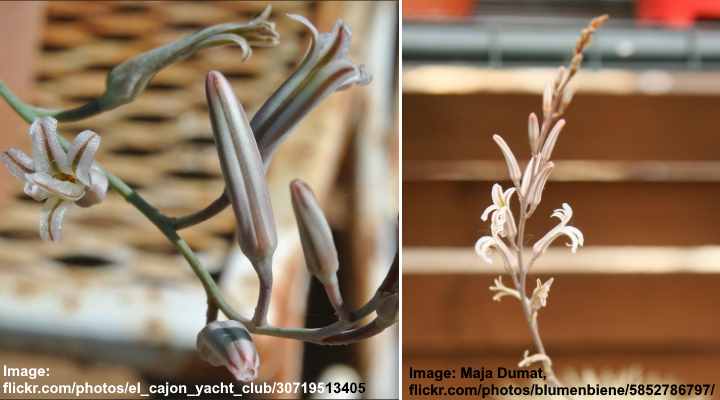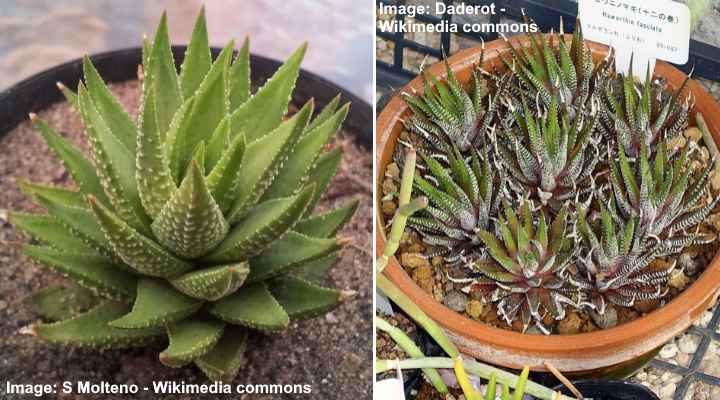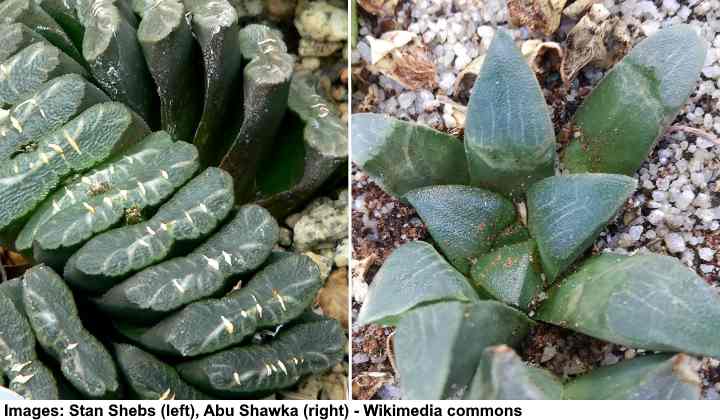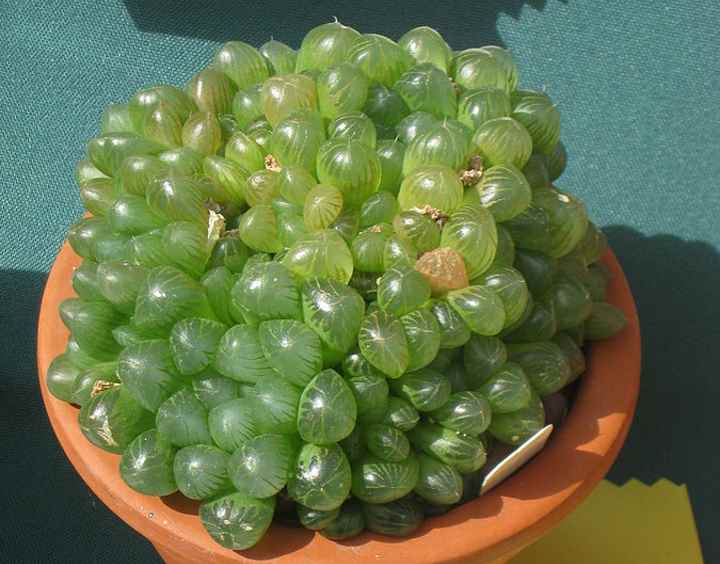Haworthia plants, which resemble tiny cacti, are small flowering succulents. Some of the simplest houseplants to maintain include common types of Haworthias, such as zebra Haworthia or Haworthia attenuata. Haworthias are tiny succulent cactus plants with rosette-shaped clusters of pointed green leaves. These low-growing plants, like other succulents, need bright light and little humidity.
How to care for Haworthia succulents: When growing in well-draining cactus soil, Haworthia plants need bright indirect sunlight. When the soil dries, Water Haworthia plants maintain an average humidity level. Temperatures of 65°F to 80°F (18°C to 26°C) are ideal for these plants.
During the summer, fertilize every few weeks. The plant family Asphodelaceae includes approximately 150 species of Haworthia plants. The small Haworthia angustifolia, the Haworthia retusa (Star cactus), and the Haworthia bayeri (fleshy leaves with striking patterns) are all common Haworthiopsis species.

Many varieties of tiny Haworthiopsis fasciata (zebra plants or Haworthia fasciata) have white markings, streaks, dots, or lumps on their fleshy leaves. Haworthia succulents may be confused with little aloe plants because of their fat, fleshy leaves and rosette form.
This is a full care guide for how to take care of Haworthia succulents. Additionally, you’ll learn how to fix some concerns with Haworthia plant care at the conclusion of the article.
How to Grow Haworthia
It’s easy to grow Haworthia indoors. All succulents, including Haworthia, should be given plenty of sunlight and occasional watering in order to thrive. Growing Haworthia plants is comparable to caring for aloe plants or other Echeveria species in many ways.
Haworthia Flowers

In the spring or summer, Haworthia fasciata blooms. The end of long stalks hold dainty white flowers. Growing conditions must be ideal for Haworthia to bloom indoors on a regular basis. Summers are characterized by warm, bright weather, while winters are characterized by chilly, dry weather.
Haworthia Succulent Care Guide
Let’s take a closer look at how to maintain healthy Haworthia plants at home. Despite their low-maintenance nature, there are a few aspects to consider when growing these small succulents.
Light Requirements of Haworthia

In bright, indirect sunlight, Haworthia succulents thrive. Plants like zebra plants or Haworthia fasciata should be placed on east or west-facing windowsills. If you keep it out of the sun’s harsh rays, Haworthia will flourish in the vicinity of a south-facing window.
Haworthia may thrive in partial shade, similar to other succulents and cacti. A zebra cactus will grow in low light in offices and north-facing rooms even if your room doesn’t have a lot of natural light. Succulents that thrive in low light, on the other hand, have sluggish development and lose their vivid green hue.
A Haworthia’s development thrives best in bright, warm environments in general. When caring for Haworthia species, it’s important to remember that strong sunlight, such as midday light, can harm the thick, meaty leaves. Yellowing leaves or leaves that turn brown are signs of too much sunlight.
The Best Soil Type for Growing Haworthias

Planting Haworthia succulents in a well-draining cactus potting mix is important if you want to take care of it properly. Mix potting soil with perlite, pumice, or little pebbles to create the ideal growing media for Haworthia succulents. These amendments inject oxygen into the growing medium, preventing it from becoming too wet.
In soggy, overly-moist soil, Haworthia fasciata (zebra succulents) will perish. The tiny houseplant will perish as a result of this wet soil, which promotes root rot. If there are no drainage holes in the pot, saturated soil may harm Haworthia growth.
The rate at which your Haworthia soil dries will tell you if it’s the right kind. After watering, the potting mixture should be dry in one to three weeks under normal circumstances. Equal proportions of potting soil and non-absorbent materials are an excellent combination for growing succulents and cactus plants. For a Haworthia potting mixture, the following soil amendments might be used:
- Perlite
- Aquarium gravel
- Poultry grit
- Horticultural pumice
- Coarse horticultural sand
How Often to Water Haworthia Succulents

When the soil becomes dry, Haworthia succulents simply need watering. Haworthia fasciata (left) and Haworthia fasciata (right) Haworthia plants drink as frequently as the potting mixture dries out. Soak the soil thoroughly with water for succulents. After that, check to see if the Haworthia needs watering again after a week or more has passed. Water these cuddly plants only every other month in the winter.
Don’t be afraid to soak the soil when watering a zebra Haworthia or other succulent species. The roots are hydrated, and the little plant gets sufficient moisture thanks to deep watering hydrates. Before watering again, you should allow the soil to dry first.
Remember that allowing a succulent to sit in prolonged wet soil is preferable than growing it in dry or slightly damp soil. Rather of watering these succulent plants on a regular basis, water them only when the soil is dry. Since various factors influence the frequency with which a Haworthia must be watered, this is the case. The following are some of the factors to consider:
- Type of pot—Terracotta pots lose moisture quicker than plastic ones when they’re exposed to air.
- Growing conditions—Summer-grown succulents need watering more often than winter-grown succulents because of the dry, hot conditions.
- Size of succulent—Water is less important for small succulents like Haworthia than for larger aloe plants.
Haworthia Fertilizer Needs

Haworthia succulents don’t need much care. Use a cactus balanced fertilizer that’s been diluted to half-strength if you decide to fertilize these succulents. In the spring, early summer, and late summer, you may apply fertilizer three times. In the winter, when they stop growing, avoid fertilizing Haworthia.
Nitrogen is an important component for Haworthia growth. The N-P-K ratio of an ideal fertilizer should be 3:1:2. Succulents, on the other hand, may grow for many years without any attention or feeding.
Ideal Temperature for Haworthia Care
Warm temperatures are ideal for Haworthia succulents. Zebra succulents thrive in average indoor temperatures of 65°F to 80°F (18°C to 26°C) as they grow indoors. The plants prefer around 50°F (10°C) during the winter dormant season. Haworthia can only be grown at temperatures of 40°F (4°C).
You shouldn’t have to worry about the temperature if you keep Haworthia succulents on a bright windowsill. Make sure there is adequate air circulation when the temperature is high or the plants are in full sun. Succulents grow well without retaining too much moisture due to the good air movement.
Haworthia Humidity Requirements
To flourish, Haworthia requires low humidity. Average household humidity is optimal for optimum haworthia development when growing as a houseplant. Increase air circulation around the plants if you live in a humid environment. Moisture problems with Haworthia succulents may be caused by too much humidity.
It’s important to ensure that there’s no humidity when growing Haworthia, even though it prefers colder winters. Succulents like Haworthia fasciata and Haworthia attenuata may die due to the combination of cold temperatures and high humidity.
How to Repot Haworthia Plants
Slow-growing houseplants that seldom need repotting are known as Haworthia species. Every two to three years, you may repot zebra succulents. Repotting may be done for a variety of reasons, including refreshing the potting soil, allowing more space for development, or separating roots for propagation. When the growth of Haworthia plants is robust, they are always repotted in the spring.
The plant from the pot before repotting Haworthia succulents. Separate any offshoots from the mother plant using a sharp clean knife. Remove any dead roots and shake off any excess dirt from the roots. Fill a three-quarters full pot with a well-draining cactus mix and take one size bigger than the current one. Fill the pot with succulents and leave the remaining area empty.
How to Propagate Haworthia Succulents
Removing offsets (pups) or rooting cut leaves are the easiest ways to propagate Haworthia succulents. Since pups develop around the mother plant, Haworthia propagation is simple. Separate the offsets and put them in fresh potting soil, and you’re done. A leaf that has been severed can root in the earth and develop.
With offsets, you may propagate Haworthia succulents.
- Remove the succulent from its pot.
- Shake the plant gently to check if any pups fall off on their own.
- Otherwise, prevent the pups from being cut with a sterile knife and ensure that there are roots on the offsets.
- Leave the mother plant’s wounds and pups exposed to fresh air for a few days.
- Wait until the soil dries before watering thoroughly after planting the new plants in fresh, moist potting soil.
From leaves, you can propagate Haworthia succulents.
- To cut a fleshy leaf from a Haworthia, use a sterile knife.
- Let the ‘wounds’ to callus over by leaving the chopped leaves on a paper towel for two to three days.
- Place the cut leaf in a well-draining potting soil for a few weeks before it takes root.
Pests Affecting Haworthia Succulent Growth
Mealybugs, spider mites, and scale insects are common pests that affect Haworthia fasciata and other species. Pest infestations may harm the plant’s look, resulting in death. It’s important for the health of your Haworthia to identify and remove signs of plant pests as soon as possible. This is what you should be on the lookout for when identifying pests that may lurk in the closely packed, spiky succulent leaves:
- Mealybugs—On the fleshy leaves, look for a white fuzzy material similar to cotton wool. You may also see mealybugs as tiny white creatures scurrying about the folds between succulent leaves.
- Spider mites—Spider mites webbing on the succulent’s foliage is a tell-tale sign. Because the mites are so tiny, you’ll be unable to see them on your plants.
- Scale insects—Since succulents seldom move, scales are difficult to detect. Scale on the succulent leaves is an indication of scale. Scale insects can be removed using a cotton swab and rubbing alcohol.
To get rid of pests from Haworthia succulents, apply a neem solution or insecticidal soap.
Diseases Affecting Haworthia Succulents
Haworthia species, like all succulents, are vulnerable to root rot. Succulent roots decay and acquire fungal diseases when there is too much moisture in the soil. The disease can eventually spread to the stem and kill the plant if it is not contained in time.
Root rot in Haworthia plants is a fungus that can be avoided with little effort. For avoiding plant disease, proper watering techniques are required. When the soil dries out, water haworthia succulent is as common as it gets. Give the potting mix a thorough soaking when watering, and let all of the water run out.
Dry leaves, poor development, or tiny withered leaves are all indications that Haworthia plants have sick roots. It is critical to check the plant’s roots for indications of damage if any of these symptoms are seen. Remove any brown, softened stems, as well as any dark-colored leaves.
Are Haworthia Plants Poisonous?
Cats, dogs, and other domestic pets are safe to have around zebra haworthia succulents. Haworthia is listed as a non-toxic houseplant by the ASPCA.
Varieties of Haworthia succulents

Several of the most popular succulent species to cultivate indoors are Haworthia truncata (left) and Haworthia bayeri (right). Haworthias are fascinating plants to grow because of their deep green leaves, white markings, and spikey appearance. The majority of individuals choose succulents based on their appearance and markings. Among the most famous Haworthia specimens are:
- Haworthia fasciata – On one side of its leaves, the legendary “zebra plant” has horizontal white stripes and dark green pointed leaves.
- Haworthia bayeri – The triangular leaves of this succulent have rounded ends.
- Haworthia attenuata – This is distinguished from the Haworthia fasciata by having white bands on both sides of the leaves. It’s also known as the zebra Haworthia.
- Haworthia truncata – The fascinating succulent has greenish succulent leaves that are rectangular and is commonly referred to as “horse’s teeth.”
- Haworthia Cooperi – Depending on the cultivar, a small uncommon succulent plant with triangular-shaped or globular translucent leaves.

Shiny clear round leaves characterize Haworthia cooperi ‘Truncata’.
FAQs about Haworthia Succulent Care
Although Haworthia succulents are easy to care for houseplants, they may have a few concerns. Your succulent plants may be suffering from one or more of the following reasons.
Why is my Haworthia turning brown?
Brown Haworthia succulent leaves are frequently caused by too much intense sun or heat. Leaves are scorched by strong sunlight, turning brown as a result. Move the tiny succulent away from direct sunlight if you notice that leaves are browning. The leaves should return to their original dark green color and unusual patterns in time.
Why is my Haworthia succulent dying?
Find out why a dying Haworthia plant is failing to thrive. Decay indicators may be seen on the roots. Save your succulent by removing dead roots and watering it less frequently if you notice root rot. Look for signs of pests if the roots on your haworthia plant look good and it appears to be dying. A simple insecticidal soap solution may be enough to save a sick Haworthia by eliminating plant pests.
How do you get a Haworthia to flower?
To bloom indoors, Haworthia succulents require the correct growing conditions. During the winter, keep the plants in the shade and refrain from watering to encourage blooming. Haworthia has time to recover and prepare for the next season’s growth while it rests.
Then start watering again when the temperature returns to normal. Your Haworthia may bloom little flowers in the spring or summer as the days grow longer and warmer.
